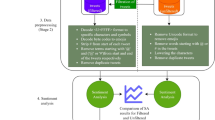Abstract
The goal of our research and experiments is to find the definitions and values of key performance indicators (KPIs) in unstructured text. The direct access to opinions of customers served as a motivating factor for us to choose Twitter data for our experiments. For our case study, we have chosen the restaurant business domain. As in the other business domains, KPIs often serve as a solution for identification of current problems. Therefore, it is essential to learn which criteria are important to restaurant guests. The mission of our Proof-of-Concept KPI discovery tool presented in this paper is to facilitate the explorative analysis taking Twitter user posts as a data source. After processing tweets with Stanford CoreNLP toolkit, aggregated values are computed and presented as visual graphs. We see our tool as an instrument for data discovery applicable, for example, to define new qualitative and quantitative KPIs based on the values found in the graph. The graph represents a complete view of aggregated data that corresponds to the search results according to the user-defined keywords, and gives easy access to detailed data (tweets) that, in its turn, leads to better understanding of the post context and its emotional coloring.
Access this chapter
Tax calculation will be finalised at checkout
Purchases are for personal use only
Similar content being viewed by others
References
Twitter Homepage. www.twitter.com. Accessed 27 Feb 2020
The Number of Tweets per Day in 2019. https://www.dsayce.com/social-media/tweets-day/. Accessed 27 Feb 2020
Chianese, A., Marulli, F., Piccialli, F.: Cultural heritage and social pulse: a semantic approach for CH sensitivity discovery in social media data. In: 2016 IEEE 10th International Conference on Semantic Computing (ICSC), Laguna Hills, CA, pp. 459–464 (2016)
Parmenter, D.: Key Performance Indicators: Developing, Implementing, and Using Winning KPIs. Wiley, New York, NY, USA (2007)
Niedritis, A., Niedrite, L., Kozmina, N.: Performance measurement framework with formal indicator definitions. In: Grabis, J., Kirikova, M. (eds.) BIR 2011. LNBIP, vol. 90, pp. 44–58. Springer, Heidelberg (2011). https://doi.org/10.1007/978-3-642-24511-4_4
Domínguez, E., et al.: A taxonomy for key performance indicators management. Comput. Stand. Interfaces 64, 24–40 (2019)
Kaplan, R.S., Norton, D.P.: The Balanced Scorecard: Measures that Drive Performance. Harvard Business School Publishing, Cambridge (2005)
Muehlen, M.: Process-driven management informations systems – combining data warehouses and workflow technology. In: ICECR-4, pp. 550–566 (2001)
Measure It to Manage It – 25 Most Important Key Performance Indicators for All Restaurant Businesses. https://www.poshighway.com/blog/25-most-important-KPIs-metrics-for-restaurant-businesses. Accessed 27 Feb 2020
Kim, S., Chung, J.-E.: Restaurant Selection Criteria: Understanding the Roles of Restaurant Type and Customers’ Sociodemographic Characteristics, Poster presented at Graduate Student Research Conference in Hospitality and Tourism. [Peer Reviewed] (2011)
Vu, H.Q., et al.: Exploring tourist dining preferences based on restaurant reviews. J. Travel Res. 58(1), 149–167 (2019)
Agüero-Torales, M.M., et al.: A cloud-based tool for sentiment analysis in reviews about restaurants on TripAdvisor. Procedia Comput. Sci. 162, 392–399 (2019)
Brito, E., et al.: A hybrid AI tool to extract key performance indicators from financial reports for benchmarking. In: Proceedings of the ACM Symposium on Document Engineering 2019, pp. 1–4 (2019)
Farzindar, A., Inkpen, D.: Natural language processing for social media. Synth. Lect. Hum. Lang. Technol. 8(2), 1–166 (2015)
Pinto, A., Gonçalo Oliveira, H., Alves, A.: Comparing the performance of different NLP toolkits in formal and social media text. In: 5th Symposium on Languages, Applications and Technologies, SLATE’16, pp. 3:1–3:16 (2016)
Denecke K.: Extracting medical concepts from medical social media with clinical NLP tools: a qualitative study. In: Proceedings of the 4th Workshop on Building and Evaluation Resources for Health and Biomedical Text Processing (2014)
Manning, C.D., et al.: The stanford CoreNLP natural language processing toolkit. In: Proceedings of 52nd Annual Meeting of the Association for Computational Linguistics: System Demonstrations, pp. 55–60 (2014)
Schuster, S., Manning, C.D.: Enhanced English universal dependencies: an improved representation for natural language understanding tasks. In: LREC’16, pp. 2371–2378 (2016)
Stanford Dependencies. https://nlp.stanford.edu/software/stanford-dependencies.shtml. Accessed 27 Feb 2020
Stanford CoreNLP Online Tool. https://corenlp.run/. Accessed 27 Feb 2020
Toutanova, K., et al.: Feature-rich part-of-speech tagging with a cyclic dependency network. In: Proceedings of the 2003 conference of the North American chapter of the Association for Computational Linguistics on Human Language Technology, vol. 1. Association for Computational Linguistics, pp. 173–180 (2003)
De Marneffe, M.-C., Manning, C.D.: Stanford typed dependencies manual. Technical report, Stanford University (2008)
Language Network. http://www.cotrino.com/2012/11/language-network/. Accessed 27 Feb 2020
Consuming streaming data. https://developer.twitter.com/en/docs/tutorials/consuming-streaming-data. Accessed 27 Feb 2020
Author information
Authors and Affiliations
Corresponding author
Editor information
Editors and Affiliations
Rights and permissions
Copyright information
© 2020 Springer Nature Switzerland AG
About this paper
Cite this paper
Zemnickis, J., Niedrite, L., Kozmina, N. (2020). A Little Bird Told Me: Discovering KPIs from Twitter Data. In: Robal, T., Haav, HM., Penjam, J., Matulevičius, R. (eds) Databases and Information Systems. DB&IS 2020. Communications in Computer and Information Science, vol 1243. Springer, Cham. https://doi.org/10.1007/978-3-030-57672-1_13
Download citation
DOI: https://doi.org/10.1007/978-3-030-57672-1_13
Published:
Publisher Name: Springer, Cham
Print ISBN: 978-3-030-57671-4
Online ISBN: 978-3-030-57672-1
eBook Packages: Computer ScienceComputer Science (R0)




